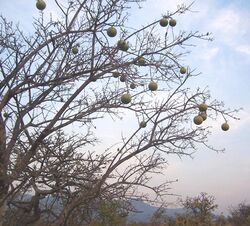Biology:Strychnos spinosa
| Strychnos spinosa | |
|---|---|

| |
| Scientific classification | |
| Kingdom: | Plantae |
| Clade: | Tracheophytes |
| Clade: | Angiosperms |
| Clade: | Eudicots |
| Clade: | Asterids |
| Order: | Gentianales |
| Family: | Loganiaceae |
| Genus: | Strychnos |
| Species: | S. spinosa
|
| Binomial name | |
| Strychnos spinosa Lam.
| |
Strychnos spinosa, the Natal orange,[1] also called Mokotra in Madagascar , is a tree indigenous to tropical and subtropical Africa. It produces sweet-sour, yellow fruits, containing numerous hard brown seeds. Greenish-white flowers grow in dense heads at the ends of branches (Sep-Feb/Spring - summer). The fruits tend to appear only after good rains. It is related to the deadly Strychnos nux-vomica, which contains strychnine. The smooth, hard fruit are large and green, ripen to yellow colour. Inside the fruit are tightly packed seeds, which may be toxic, surrounded by a fleshy, brown, edible covering.
Animals such as baboon, monkeys, bushpig, nyala and eland eat the fruit. The leaves are a popular food source for browsers such as duiker, kudu, impala, steenbok, nyala and elephant.[2]
Distribution
This tree can be found growing singly in well-drained soils. It is found in bushveld, riverine fringes, sand forest and coastal bush from the Eastern Cape to Kwazulu-Natal, northwards to Mozambique, and inland to Eswatini, Zimbabwe, parts of Zambia specifically the western part of Zambia since it is sandy and some parts of southern province of Zambia , northern Botswana, northern Namibia, Angola, Guinea Bissau, to tropical Africa, north west Madagascar, south east Madagascar at Sainte Luce Reserve, Southern Kenya on the lower parts of Eastern arc mountains, north west Ethiopia, and western Tigray at Kafta Sheraro National Park. It is able to grow in semi-arid and arid lands.
Traditional medicine
The plant, taken alone or in conjunction with extracts of other plants, is used by the Tiv people of Nigeria for snakebites, venereal disease, increasing the flow of breastmilk in lactating mothers, and enhancing physical strength.
Chemistry
An iridoid, sarracenin, has been isolated from the root bark of Strychnos spinosa.[3]
References
- ↑ "Strychnos spinosa". Natural Resources Conservation Service PLANTS Database. USDA. https://plants.usda.gov/core/profile?symbol=STSP8. Retrieved 4 December 2015.
- ↑ Pasternak, Dov, ed (2001) (in en). Combating Desertification with Plants. Boston, MA: Springer US. pp. 35. doi:10.1007/978-1-4615-1327-8. ISBN 978-1-4613-5499-4. http://link.springer.com/10.1007/978-1-4615-1327-8.
- ↑ Tor-Anyiin T. A et al. (April 2015). "ISOLATION AND ANTIMICROBIAL ACTIVITY OF SARRACENIN FROM ROOT BARK OF (Strychnos spinosa Lam.)". J. Chem.Soc.Nigeria. 40 (1): 71–75.
External links
- "Characterization of monkey orange (Strychnos spinosa Lam.), a potential new crop for arid regions". J. Agric. Food Chem. 51 (21): 6256–60. October 2003. doi:10.1021/jf030289e. PMID 14518952.
- PlantZAfrica.com description
- New Fruits for Arid Climates
- {{citation
| mode = cs1 | title = Strychnos spinosa | work = Germplasm Resources Information Network (GRIN) | url = | publisher = [[Organization:Agricultural Research ServAgricultural Research Service (ARS), United States Department of Agriculture (USDA) | access-date = }}
Wikidata ☰ Q2704877 entry
 |



